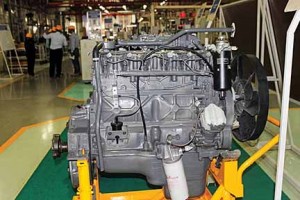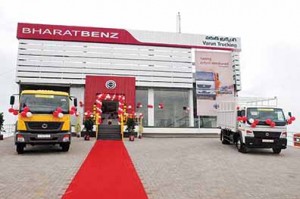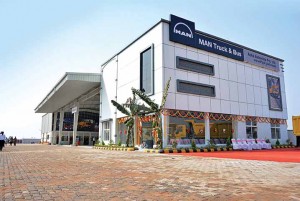After a tumultuous last year, the CV industry is looking at a rare new period.
Story by: Ashish Bhatia
Supreme Court’s judgement to stop the sale of BSIII emission compliant vehicles on April 01, 2017, led to an unprecedented situation. CV manufacturers and dealers were left with an estimated inventory of 96,700 (and 40,048 three-wheelers) BSIII emission compliant CVs as on March 30, 2017, amounting to a sum of Rs.2500 crore approximately. With the Supreme Court order clearly stating that on and from April 01, 2017, such vehicles that are not BSIV compliant shall not be sold in India by any manufacturer or dealer, led CV industry stakeholders to look at quick ways of off-loading as many BSIII emission compliant CVs as they could in a short span of three-to-four days; from the time the Supreme Court gave the order and from the time BSIV emission norms came into force on April 01, 2017. The scope of the Supreme Court judgement can be had from the fact that it ordered all the vehicle-registration authorities under the Motor Vehicles Act, 1988, to not register such vehicles on and from April 01, 2017, that do not meet BSIV emission standards, except on proof that such a vehicle has already been sold on or before March 31, 2017. It was no secret that BSIV emission norms will come into force from April 01, 2017. The CV industry knew it. What the CV industry did not know, claimed an industry source, was if they should discontinue manufacturing BSIII vehicles such that there will not lie a single unit with them or their dealers on April 01, 2017. He drew attention to the fact that manufacturers were entitled to manufacture BSIII emission compliant vehicles till March 31, 2017. He also drew attention to the Centre’s response on pleas filed by Bajaj Auto and Environmental Pollution Control Authority (EPCA) in the Supreme Court, that the sale and registration of BSIII vehicles can continue after March 31, 2017, and the cut-off applies to manufacturing only. During the March 24, 2017, hearing, claimed an industry source, the court had considered allowing registration of BSIII vehicles by imposing a compensatory cess. The Centre’s response is said to have been based on two earlier instances of upgrading to BSII and BSIII emission norms respectively. Then, the sale of existing stock was allowed.
Bone of contention
Mentioning in its order that the health of the people of India is of greater importance than the losses the auto industry would suffer (sic), the Supreme Court was not impressed by the argument that manufacturers be allowed to sale BSIII vehicles even after the BSIV regulation was implemented.
Claimed an industry source that the ministry of transport issued a notification on August 19, 2015, to switch to BSIV emission compliant vehicles on April 01, 2017. It did not however clarify whether production of BSIII vehicles would have to be stopped, or also their sale. Interestingly, the Supreme Court did not fail to observe the fact that an expenditure of Rs.30,000 crore was incurred by refineries to produce BSIV grade of fuel. The Court in its order stated that manufacturers failed to take pro-active steps despite being aware of the timelines. Much confusion prevailed until the Supreme Court issued an order on March 28, 2017, to stop the sale of BSIII vehicles on March 31, 2017.
Dealing with the impact
Left with no choice, CV industry stakeholders came up with the prospect of fire-sale. With the Court order coming out three-to-four days before April 01, 2017, the auto industry, and not just the CV industry saw fire-sale as a promising prospect, which is not surprising. Many two wheeler manufacturers too resorted to fire-sale of their BSIII vehicles as well.
Expressed Vinod K. Dasari, Managing Director and Chief Executive Officer, Ashok Leyland, and President, Society of Indian Automobile Manufacturers (SIAM), that they are looking at exporting the leftover (BSIII vehicles) inventory to emerging markets, currently complying with BSIII norms. Claimed an industry source that those (vehicles) that are left behind will be dismantled. Some of the aggregates could be rescued. Alternatively, the vehicles could be upgraded to BSIV if possible. A statement issued by Mahindra & Mahindra announced that the Group is ramping up BSIV vehicle production. The OEM, the statement read, is also exploring options within the framework to minimise the impact. The brisk discount sales and incentives CV makers offered to off-load BSIII vehicles in the three-to-four days costed them in the region of Rs.2500 crore, claimed an industry source. According to a report by research firm Crisil, companies sold a little over half of their BSIII inventory by March 31, and have lost Rs 1,200 crore on discounts and incentives. They are expected to lose another Rs.1,300 crore to dispose off the unsold inventory.
Mentioned a Tata Motors source that the ban would have a material impact on all the CV industry stakeholders. They are, he mentioned, assessing unsold inventory that lies with the company and the dealerships. According to the Tata Motors spokesperson, the decision to ban the sale of BSIII vehicles was unprecedented and unexpected. Erich Nesselhauf, Managing Director and Chief Executive Officer, Daimler India Commercial Vehicles (DICV), expressed that they planned a year in advance to meet the BSIV deadline. The company, he added, has sold its 1000th BSIV truck in the state of Kerala recently. Kerala migrated to BSIV emission norms in November 2016, much before the pan-India BSIV regulation came into force last month. Despite prior planning, DICV has come to have an unsold inventory of 200 BSIII CVs, said Nesselhauf on the sidelines of the launch of BSIV BharatBenz HDTs at Chennai. DICV had its CVs shed 400 kgs to accommodate BSIV apparatus. The company has adapted SCR technology to meet BSIV emission norms unlike Ashok Leyland, which has adapted intelligent EGR technology to meet BSIV emission norms. DICV is supplying AdBlue solution to its dealers (and to petrol pumps) to ensure quality and reliability. The price of BharatBenz BSIV CVs is the same as the price of the
BSIII CVs.
Dealer impact
The impact on CV dealerships was considerable. Dealers came under immense pressure to off-load BSIII CVs. If slow moving inventory made for a higher impact, dealers panicked at least in the beginning. Averred Piyush Jain of A V Motors, a SML Isuzu dealer, that the ruling is hard hitting, and has rendered dealers helpless. Jain compared the development with that of demonetisation. Demonetisation too hit us hard in the third quarter of FY2016-17, he said. “A strong (and clear) judgment should have been passed about discontinuing the manufacture of BSIII vehicles in 2016 itself,” opined Jain. “Had such a ruling been passed in 2016, it would have not resulted in the quantum of losses that we are staring at today,” he added.
Jain also touched upon the fear of electronics among CV buyers and operators. “The customer here is far from being accustomed with the high level of sophistication (electronic engine) BSIV emission regulation will call for,” said Piyush. He informed that he had an inventory of 20 BSIII vehicles. Apprehensive of the volumes in the first quarter of FY2017-18, Tej Ghatge of Chetan Motors, a Tata SCV dealer from Kolhapur said that he held an inventory of 55 vehicles as on March 31, 2017. Of these, he managed to fire-sale 20 vehicles. Huge discounts were offered. Discounts of Rs.50,000 on a Tata Ace was offered. Vimal Gujral of Cargo Motors, a Gandhidham-based Tata CV dealer, expressed that the development was shocking. He held an inventory of 500 vehicles as on March 31, 2017. If his regional centres would be accounted for, the count would go up to 700 vehicles. Not a happy prospect for certain, opined Gujral. With unsold inventory accounting mainly for Small Commercial Vehicles (SCVs) and pick-up trucks, Gujral revealed that they have hiked the discounts considerably.
Stating that the higher price differential between BSIII and BSIV emission compliant CVs is yet to result in a clear picture as far as the demand in CV industry goes, Gurjral said, “We are yet to witness demand for BSIV CVs.” Mentioned a prominent CV dealer, that they have been advised by their principal to register (BSIII) vehicles in their name. “There is a limit to the number of vehicles we can register in our name,” he said. Suresh Jain of Veerprabhu Marketing, a CV dealer from Jodhpur, expressed that inventory levels are usually higher at the end of the financial year. This is done to realise depreciation benefits by billing the inventory over the financial year end. With customers expecting unrealistic discounts, and at times below the cost of goods sold, it is not a happy prospect since the dealer has already been billed for local transportation, local taxation and sales tax among other charges, averred Jain. Jain’s dealership held an inventory of 200 vehicles as on March 31, 2017.
As a desperate measure CV dealers are known to give an extended credit of up to 30 days to some of their large fleet operator clients to off-load BSIII inventory. Said a dealer on the condition of anonymity, that the impact of Supreme Court’s order and the slow demand for BSIV CVs will reflect in the sales statistics for the first quarter of FY2017-18. The CV industry, he averred, will perform worst than when it was impacted by demonetisation.
Expert analysis
With the Crisil report pegging the CV industry loss at Rs.2,500 crore, the total impact of the Supreme Court order is claimed to be 2.5 per cent of the annual revenues of listed CV manufacturers. According to the Crisil report, an expense of another Rs.1,300 crore will be incurred to dispose off unsold inventory of BSIII CVs. The effect of this development, claimed an industry source, will be spread across FY2017-18. The discounts offered during the fire-sale of BSIII vehicles is also expected to negatively impact EBITDA margins by 100 bps (one per cent) in FY2017-18. Expressed Rakesh Batra, Partner and automotive sector leader at Ernst and Young Services, that it is necessary to consider that the CV industry works globally on 20 to 30 days of inventory. This is within the distribution channel, and should have been accounted for as part of the plan to transition from BSIII to BSIV emission norms. An ICRA report pegged unsold inventory of BSIII CVs to between Rs.4600 and Rs.5800 crore approximately. Despite being caught off-guard by the SC ruling, SIAM’s latest report states the overall commercial vehicle segment to have registered a 4.16 per cent growth in FY2016-17. Medium and Heavy Commercial Vehicles (M&HCVs) grew by 0.04 per cent over the same period last year. Light Commercial Vehicles (LCVs) witnessed a 7.41 per cent growth while CV exports registered a 4.99 per cent growth.
Looking for clarity
The Society of Indian Automobile Manufacturers (SIAM) has written to Prime Minister Narendra Modi, seeking a meeting, claimed an industry source. The letter, he mentioned, speaks about the auto industry wanting to thrive in an environment where there is policy clarity and certainty. Especially, due to the long gestation period involved. Claimed a source on the condition of anonymity that the recent Supreme Court ruling contradicts the 2015 notification by the transport ministry. He mentioned that this has been mentioned by SIAM in the letter it wrote to the Prime Minister. The fact is, the die has been cast. BSIII CVs are history. The road ahead lies on the frame work of tightening regulations starting with BSIV. With the crash regulations said to come into force from next fiscal, the road ahead for the Indian CV industry is going to be as challenging as it has been for sometime now. With GST round the corner, the CV industry, it is looking like, is already anticipating big changes. In 2020, the bridge to BSVI emission norms will have to be crossed too.























